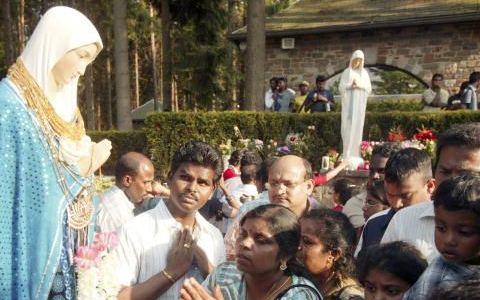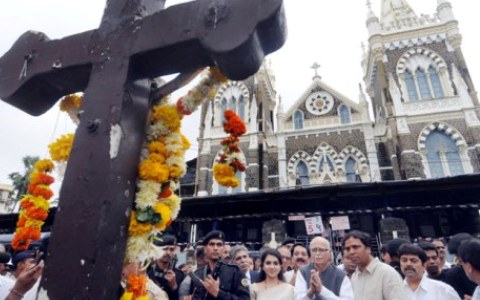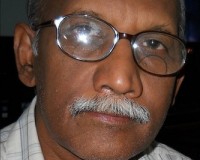Is Hindu worship of Marian shrines a sign of growing religious tolerance?
by - 22nd October 2014

An unexpected rise in Hindus venerating the Virgin Mary alongside their own goddesses, like Pavarti and Durga, is highlighting her growing appeal across religious borders.
Commenting on the rising number of Hindus visiting Lourdes, Father Brian De Burcan, one of its chaplains said: 'all are welcome'. Up to five million people travel to Lourdes each year.
Kunthi is a typical worshipper. She is a Hindu woman in her thirties who lives in the part of Paris known as Little India, and is one of the district’s most devoted followers of Mary. She goes on a pilgrimage to the Sancutary of Our Lady of Lourdes every year.
A statue of Mary sits on the counter of the Indian boutique where she works on Rue Philippe De Girard.
Beside it is an icon of Kali, the Hindu goddess of time and change.
‘I pray to Mary because her son Jesus has a good heart,’ she said.
Philosophical
Priests at the nearby Manicka Vinayakar Alayam temple on Rue Pajol are philosophical about Hindus venerating Mary, saying they would 'never tell a Hindu who or what to worship'.
They arrived in France in the 1950s from Pondicherry and were granted citizenship when the French outpost was assigned to India following its independence.
They have been credited with creating the alluring Little India district around Paris’s Gare du Nord, which is now the business epicenter of France’s 33,000 Indian population with its thriving hub of restaurants, cash-and-carries and sari boutiques.
In India, Mary is also enjoying an elevated status among Hindus - the majority faith - who make up more than 80 percent of the population.
They habitually venerate her, as do Parsees, Muslims and Jains.

Their devotion takes the form of pilgrimages to India’s numerous Marian shrines, including Mount Mary in Mumbai.
They also attend masses in Catholic churches. Some even keep statues and pictures of Mary at home besides images of Hindu gods and goddesses.
Myron Pereira, a Mumbai-based Jesuit priest said Hindu women are more devoted to Mary than men.
Suffering
This is because they identify with her experience and suffering more than most men.
‘Mothers especially pray about their family’s health and a good supportive husband with a steady job,’ he said.
In addition, they pray for children if they have problems conceiving.
They also ask Mary to intercede for a good match, for themselves if unmarried and for their daughters.
The flow of Hindus to Marian shrines prompted Pereira to enquire why they worship Mary when they have their own gods and goddesses.
They answered that they identified with her maternal aspect as the mother who carries her child.
‘This is one of the oldest and most persistent archetypes of the goddess,’ Pereira said – ‘the childbearing, nurturing, protective woman and Mary fulfills this role perfectly.
Mother Goddess
The Mother Goddess is a universally recognised maternal symbol of fertility, birth and caring represented by a variety of icons, deities and images.
‘Certainly she does so better than Parvati or Durga who are both, incidentally, forms of the Mother Godess in India.
‘They are related to the fecundity of the earth and the womb and of sexual energy or shakti in general,’ Pereira added.
Pereira believes Mary is more benevolent than either Durga or Parvati.
On Mary offering a new nirvana of interfaith tolerance, he stated that much more needed to be done.
 ‘All genuine devotion helps to build bridges of peace and understanding, so in this sense the Blessed Virgin Mary does help in interfaith understanding,’ he said.
‘All genuine devotion helps to build bridges of peace and understanding, so in this sense the Blessed Virgin Mary does help in interfaith understanding,’ he said.
‘However, much of this faith exists at a superficial level in India in that it is related to personal petition and thanksgiving.
‘There is little social awareness or outreach.’
Pereira appeals to Christians, Hindus and Muslims in India to better understand each other’s beliefs, symbols and common history.
He believes this was still seen as too threatening in India.
‘Perhaps it is because the earlier Christian attitude to conversion acted as a deterrent to mutual understanding,’ he explained.
First and foremost, he thinks there needs to be a change in the hierarchical Catholic Church.
Oppressed
‘It must not be too narrowly focused on numerical conversions, but more on bringing about social change, justice and equality for all, especially for the oppressed in Indian society,’ he added.
‘But the Indian state is hostile to such changes, because they reveal the deep injustices in society, and a Church that initiates such will be liable to persecution.'
Pereira thinks that a change of attitude is also needed on the part of Hindus to work for a genuinely inclusive society.
‘In this, traditional caste attitudes are the greatest liability. Hindus, particularly, do not feel responsible for those not of their own caste or community,’ he said.
‘This gross irresponsibility,' which, he states, reveals itself in ecological degradation and workforce injustices, 'is part of the crisis of corporate capitalism in India today’.
For now, it seems, Mary remains a personal religious symbol rather than a major force for inter-faith social change.
